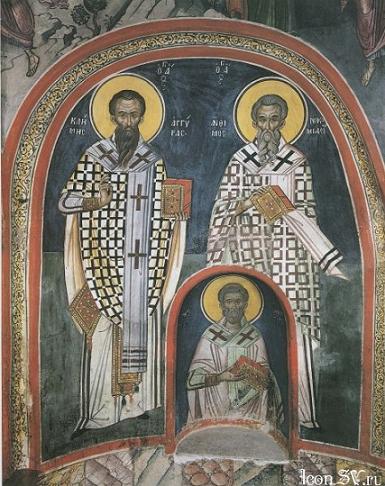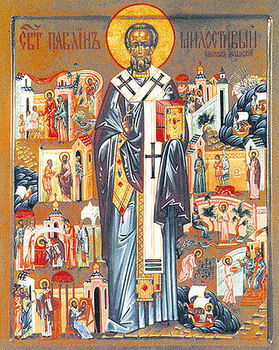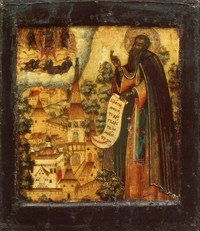|
|
The Priestly-Martyr Clement, Bishop Of Ancyra Clement was born in the year 258 A.D. in the city of Ancyra of a pagan father and a Christian mother. His devout mother Euphrosyne prophesised that her son would die a martyr"s death and then she departed this world when Clement was twelve years old. Her friend Sophia took Clement to her home as a son and assisted in rearing him in the Christian spirit. Clement was so famous because of his virtuous living that he was elected bishop of Ancyra at the age of twenty. In his young years, he attained the wisdom of a mature adult, and by great restraint he tamed and conquered his body. Clement fed on bread and vegetables only and did not eat anything butchered or bloody. During the reign of Diocletian, he was tortured so horribly "as no one ever, since the beginning of the world." He spent twenty-eight years in difficulties and in dungeons. Eleven different torturers tormented and tortured him. At one time, when they struck him in the face, spat upon him and broke his teeth, he cried out to Domentian, his torturer: "You do me great honor, O Domentian, for you are not torturing me, because even the mouth of my Lord Jesus Christ was also beaten and struck in the face and behold, I , the unworthy, now became worthy of that!" When Clement was brought to Rome before Emperor Diocletian, the emperor placed various weapons on one side for torture and on the other side gifts, such as decorations [medals], clothing and money; all that the emperor could bestow, and then he told Clement to choose. The martyr of Christ glanced with scorn at all the emperor"s gifts and chose the instruments of torture. Clement was indescribably tortured: piece by piece they removed the flesh from his body so that the white bones showed beneath the flesh. Finally, he was beheaded by a soldier in Ancyra while, as bishop, he was celebrating the Divine Liturgy in church in the year 312 A.D. The miracles of St. Clement are without number. Clement was born in the year 258 A.D. in the city of Ancyra of a pagan father and a Christian mother. His devout mother Euphrosyne prophesised that her son would die a martyr"s death and then she departed this world when Clement was twelve years old. Her friend Sophia took Clement to her home as a son and assisted in rearing him in the Christian spirit. Clement was so famous because of his virtuous living that he was elected bishop of Ancyra at the age of twenty. In his young years, he attained the wisdom of a mature adult, and by great restraint he tamed and conquered his body. Clement fed on bread and vegetables only and did not eat anything butchered or bloody. During the reign of Diocletian, he was tortured so horribly "as no one ever, since the beginning of the world." He spent twenty-eight years in difficulties and in dungeons. Eleven different torturers tormented and tortured him. At one time, when they struck him in the face, spat upon him and broke his teeth, he cried out to Domentian, his torturer: "You do me great honor, O Domentian, for you are not torturing me, because even the mouth of my Lord Jesus Christ was also beaten and struck in the face and behold, I , the unworthy, now became worthy of that!" When Clement was brought to Rome before Emperor Diocletian, the emperor placed various weapons on one side for torture and on the other side gifts, such as decorations [medals], clothing and money; all that the emperor could bestow, and then he told Clement to choose. The martyr of Christ glanced with scorn at all the emperor"s gifts and chose the instruments of torture. Clement was indescribably tortured: piece by piece they removed the flesh from his body so that the white bones showed beneath the flesh. Finally, he was beheaded by a soldier in Ancyra while, as bishop, he was celebrating the Divine Liturgy in church in the year 312 A.D. The miracles of St. Clement are without number.The Sixth Ecumenical Council [Constantinople, 680 AD.]![The Sixth Ecumenical Council [Constantinople, 680 AD.]](kalendar_new/det_kal_imgs/23-00.jpg) The first session was held in Constantinople in the first half of the year 681 A.D., and the second session was held in the second half of the year 691 A.D. This Council condemned the Monothelite heresy, which erroneously taught that in Christ there was only one divine will and not a human will. Along with this, the Council passed several canons concerning the order and discipline of the clergy. The first session was held in Constantinople in the first half of the year 681 A.D., and the second session was held in the second half of the year 691 A.D. This Council condemned the Monothelite heresy, which erroneously taught that in Christ there was only one divine will and not a human will. Along with this, the Council passed several canons concerning the order and discipline of the clergy.Saint Paulinus The Merciful At first, Paulinus was a Roman senator and afterwards, a bishop in Nola. He followed the example of his friend St. Ambrose and received baptism. Following his baptism, Paulinus withdrew to Spain and into the Pyrenees mountains where he lived a life of asceticism. But as no lighted lamp can be hidden, so also St. Paulinus was discovered and elected as Bishop of Nola. He was a good and merciful shepherd. He died peacefully in the year 431 A.D. His relics repose in the Church of St. Bartholomew in Rome. At first, Paulinus was a Roman senator and afterwards, a bishop in Nola. He followed the example of his friend St. Ambrose and received baptism. Following his baptism, Paulinus withdrew to Spain and into the Pyrenees mountains where he lived a life of asceticism. But as no lighted lamp can be hidden, so also St. Paulinus was discovered and elected as Bishop of Nola. He was a good and merciful shepherd. He died peacefully in the year 431 A.D. His relics repose in the Church of St. Bartholomew in Rome.Venerable EusebiusRecluse of Mount Coryphe near Antioch (4th century)
Venerable Mausimas the SyrianSaint Mausimas the Syrian lived in Syria, near the city of Cyrrhus. He voluntarily embraced poverty and devoted his life to the service of his neighbor. The doors of his hut were always open to anyone who had need of him.
In his hut there were two vessels: one with bread, and the other with oil. Anyone in need came to him and received the food from his hand. These vessels never became empty. The saint died at the end of the fourth century.
Venerable Salamanes the Silent of the EuphratesSaint Salamanes the Silent was a native of the city of Kapersana, near the River Euphrates. Having found a cave near the banks of the river, he lived there as a hermit in silence and asceticism.
Learning of his exalted life, the Bishop of Kapersana wanted to ordain him to the holy priesthood, but the hesychast would not answer him with even a single word. The holy ascetic did not break his silence, conversing with the Lord alone. The Orthodox Church venerates him as the first saint to have taken upon himself the exploit of silence, which he continued to his very end (+ ca. 400).
Venerable Gennadius of Kostroma Saint Gennadius of Kostroma and Liubimograd, in the world Gregory, was born in the city of Mogilev into a rich family. He early displayed love for the church, and his frequent visits to monasteries evoked the dismay of his parents. Gregory, however, was firmly resolved to devote himself to God, and changing into tattered clothing, he secretly left his parental home and journeyed to Moscow.
He visited the holy places in Moscow, but he did not find it suitable in spirit and so set out to the Novgorod region. The destiny of the future ascetic was decided by an encounter with St Alexander of Svir (August 30). With his blessing, Gregory went to the Vologda forest to St Cornelius of Komel (May 19), and was tonsured by him with the name Gennadius. Together with St Cornelius, Gennadius moved on to the Kostroma forest. Here, on the shores of Lake Sura, in about the year 1529, there emerged the monastery of the Transfiguration of the Lord, afterwards called “the Gennadiev monastery”. Having become igumen, St Gennadius did not slacken his monastic efforts, and together with the brethren he went out to the monastery tasks: he chopped wood, carried firewood, made candles and baked prosphora. He also wore heavy chains. One of his favorite tasks was the painting of icons, with which he adorned his new monastery.
For his holy life St Gennadius received from the Lord the gift of clairvoyance and wonderworking. Journeying to Moscow on monastic affairs, at the house of the nobleman Roman Zakharin, the saint predicted to his daughter Anastasia that she would become Tsaritsa. Indeed, Tsar Ivan the Terrible chose her as his wife.
The Life of St Gennadius was written by his disciple, Iguman Alexis, between the years 1584-1587. In it was inserted his spiritual testament, dictated by St Gennadius himself. In it he commands the monks to observe the monastery Rule, to toil constantly, to be at peace with everyone, and to preserve the books collected at the monastery, while striving to understand their meaning. He said, “Strive towards the light, and shun the darkness.”
St Gennadius died on January 23, 1565, and was glorified by the Church on August 19, 1646. Saint Gennadius of Kostroma and Liubimograd, in the world Gregory, was born in the city of Mogilev into a rich family. He early displayed love for the church, and his frequent visits to monasteries evoked the dismay of his parents. Gregory, however, was firmly resolved to devote himself to God, and changing into tattered clothing, he secretly left his parental home and journeyed to Moscow.
He visited the holy places in Moscow, but he did not find it suitable in spirit and so set out to the Novgorod region. The destiny of the future ascetic was decided by an encounter with St Alexander of Svir (August 30). With his blessing, Gregory went to the Vologda forest to St Cornelius of Komel (May 19), and was tonsured by him with the name Gennadius. Together with St Cornelius, Gennadius moved on to the Kostroma forest. Here, on the shores of Lake Sura, in about the year 1529, there emerged the monastery of the Transfiguration of the Lord, afterwards called “the Gennadiev monastery”. Having become igumen, St Gennadius did not slacken his monastic efforts, and together with the brethren he went out to the monastery tasks: he chopped wood, carried firewood, made candles and baked prosphora. He also wore heavy chains. One of his favorite tasks was the painting of icons, with which he adorned his new monastery.
For his holy life St Gennadius received from the Lord the gift of clairvoyance and wonderworking. Journeying to Moscow on monastic affairs, at the house of the nobleman Roman Zakharin, the saint predicted to his daughter Anastasia that she would become Tsaritsa. Indeed, Tsar Ivan the Terrible chose her as his wife.
The Life of St Gennadius was written by his disciple, Iguman Alexis, between the years 1584-1587. In it was inserted his spiritual testament, dictated by St Gennadius himself. In it he commands the monks to observe the monastery Rule, to toil constantly, to be at peace with everyone, and to preserve the books collected at the monastery, while striving to understand their meaning. He said, “Strive towards the light, and shun the darkness.”
St Gennadius died on January 23, 1565, and was glorified by the Church on August 19, 1646. The Holy Two Martyrs of PariumNear Cyzicus and Lampsacus, in Asia Minor
|